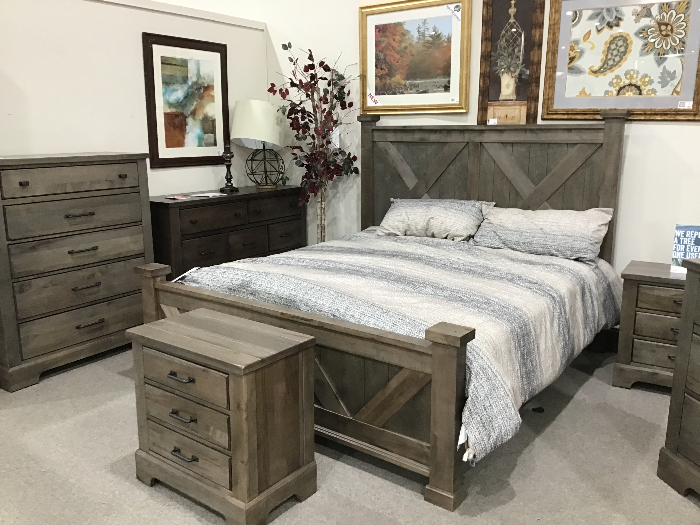The case goods company made a series of changes that helped increase its production of bedroom furniture by nearly 70%. Now it’s on pace to sell $100 million in 2021.
When the pandemic began and Vaughan-Bassett was forced to close its factories for six weeks, they were fortunate to be carrying “too much” inventory at that time—just over $30 million in finished goods.
According to Executive VP and COO Doug Bassett, business exploded in late May of 2020, and because of that inventory numbers started to drop quickly. As the company saw no end in sight for how strong business would be, they made a series of decisions to help increase production and meet demand.

It was the domestic case goods manufacturer’s quick moves that led one retailer recently to praise the company for its wartime mentality mode, ensuring product flowed throughout the pandemic.
First, in July of 2020, the company shut down its particleboard plant in Galax, Va., and brought 50 of the 60 employees over to work in the bedroom factory, which is just down the street from the old particleboard factory.
“On Friday when the particleboard plant shut down, we told them we’d retrain them and put them in bedroom factory on Monday,” Bassett explains. “Most of our workforce was interested in doing that, and that gave us a huge infusion of additional employees, which was a key driver in helping us get production up.”
On top of that, the company hired another 75 employees and has increased production of bedroom furniture from $1.1 to $1.2 million per week in July 2020 to $2.0 million in production per week in May 2021—at least a 70% increase.
The company also started dropping underperforming groups last summer and quickly started realizing their retailers were filling their floors with Vaughan-Bassett products.
“To guarantee quick delivery to our dealers, we recognized early that we would be unable to service a line-up of 24 bedroom collections and almost 2000 SKUs,” Bassett says. “So we have been brutal about underperforming groups, finishes, and pieces for the last year. Today we only have 10 active collections in our line-up, and we have only 800 SKUs. This is a reduction of over 60% of our groups and exactly 60% of our SKUs.”
All of those drops didn’t affect order rate—it stayed consistently strong up near $2 million a week, according to Bassett, but it allowed the company to continue to service the line well with a lot less inventory.

Vaughan-Bassett can cycle through this lineup every 14-15 weeks, which means they are never out of a group longer than 60 days and about 60% of their line-up is in stock on any given day and available for immediate shipment. Bassett’s average order is shipped in three weeks or less.
“If we told dealers we’d be out for six weeks but that something would ship out in October, we were accurate within a day or two of when a group was coming back into stock,” Bassett explains. “And over time, the dealers realized they could rely on our projections. The fact that we are delivering so much faster than our Asia n competition—which is where about 90% of all bedroom furniture comes from—we’ve been picking up slots on our dealer’s floors for over a year now.”
And Vaughan-Bassett’s efforts paid off. Its bedroom division, which makes up about 90% of the company, sold $62 million in 2019 and is on pace to sell $100 million in 2021—a 60% growth over a period of about two years.
Bassett says the company spends a lot of time talking to its dealers and trying to ascertain when inventory from Asia will improve, and everything they read and are being told by dealers is that it will be a minimum of six more months before things might improve—and it may be a year or more.
“It’s an advantage right now to be an American manufacturer,” Bassett explains. “We are closer in proximity to our customers. We are providing better delivery and service and the costs associated with transporting our goods to the dealers have gone up much less than the cost of Asian competitors.”
And while recent lumber shortages have made product more expensive, it hasn’t slowed the company down.
“The cost of oak and poplar almost doubled, for a while, but it’s backing off now,” Bassett explains. “Everything from glue to cartons to finishing material, veneers, hardware—everything has increased at least double digits in the first few months of 2021.”
And with that, he also says he understands that the “sugar high” in the furniture industry will not last forever and that as people spend less of their wallet share on furniture, Vaughan-Bassett will likely add a few more active collections to the mix.
“For the next six months to a year, I think we will likely pursue a similar strategy with only nine or 10 active groups, a short lineup, and very limited intros each market cycle,” Bassett says. “If you ask me where we’ll be in two to three years, it’s probably going somewhere between 12-14 active collections. I think we’ll go a little bigger than we are today, but nowhere close to the 24 we had at the beginning of 2020.”










.jpg)





